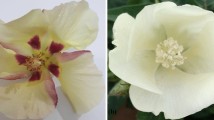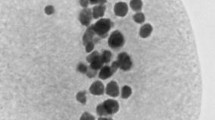VII. Summary
1. Of two interspecific hybrids between Asiatic and New World cottons studied, one had 2n = 39 and the other 2n = 52. For the latter, the inference is that a diploid egg from Asiatic cotton had functioned.
2. In a study of the somatic chromosomes of New World cotton it has been found that half of the chromosomes are small and the other half larger, the latter being comparable in size to the chromosomes of Asiatic cotton. The small chromosomes of New World cotton are of the same size as those in diploid wild species from North America. Species from the Old World and from Australia are all characterised by the larger size of their chromosomes.
3. In the first meiotic division it was seen that (1) at least 13 univalent chromosomes are present in both hybrids, and (2) the hybrid with 52 chromosomes shows the same chromosome conjugation as in a triploid Asiatic cotton, but with the addition of an extra set of 13 non-homologous chromosomes.
4. The conclusion was drawn that New World cottons are allopolyploid species. It is thought that these probably originated from a cross between two species ofGossypium both withn = 13 but possessing morphologically dissimilar and non-homologous sets of chromosomes. The inference is that one of the parental species was an Asiatic cotton or a very closely allied type, while the other was probably a New World species characterised by its smaller chromosomes.
Similar content being viewed by others
References
Darlington, C. D. (1931). “Meiosis.”Biological Reviews,6, 221–64.
Gates, R. R. andThomas, N. (1914). “A cytological study ofOenothera mut.lata andOc. mut.semilata in relation to mutation.”Quart. Journ. of Mic. Sci.59, 523–71.
Hagerup, O. (1932). “Über Polyploidie in Beziehung zu Klima, Ökologie und Phylogenie.”Hereditas,16, 19–40.
Harland, S. C. (1932). “Fertility in hybrids between New and Old World cottons.”Nature,129, 398.
Hutchinson, J. B. (1932). “The genetics of cotton. Part VIII. The inheritance of anthocyanin pigmentation in Asiatic cottons.”Journ. Gen.26, 317–39.
Johansen, D. A. (1932a). “A new method of differentiating Gentian Violet when used as a somatic chromosome stain.”Stain Technology,7, 17–20.
—— (1932b). “Further notes on the use of Gentian Violet as a somatic chromosome stain.” Ibid.,7, 107.
Lewitsky, G. A. (1931). “The morphology of the chromosomes.”Bull. Appl. Bot., Genet. and Plant Breed.27, 103–74.
Longley, A. E. (1933). “Chromosomes inGossypium and related genera.”Journ. Agric. Research,46, 217–27.
Meurman, O. (1928). “Cytological studies in the genusRibes L.”Hereditas,11, 289–356.
Müntzing, A. (1932). “Cyto-genetic investigations on syntheticGaleopsis Tetrahit.” Ibid.,16, 105–54.
Nakatomi, S. (1931). “Hybridization between Old World and New World cotton species and the chromosome behavior of the pollen mother-cells in theF1 hybrid.”Jap. Journ. Bot.5, 371–84.
Rosenberg, O. (1909). “Cytologische und morphologische Studien anDrosera longifolia × rotundifolia.”Kungl. Svenska Vetenskapsakademiens Handlingar,43, No.II, 1909.
Skovsted, A. (1929). “Cytological investigations of the genusAesculus L.”Hereditas,12, 64–70.
—— (1933). “Cytological studies in cotton: I. The mitosis and the meiosis in diploid and triploid Asiatic cotton.”Ann. Bot. 47, 227–51.
Szymanek, J. (1932). “Observations caryologiques supplémentaires sur quelquesGossypium.”C.R. de l’Académie des Sciences, Paris, 1932,194, 1011–13.
Szymanek, J. andGavaudan, P. (1932). “Observations caryologiques sur quelquesGossypium.” Ibid., 1932,194, 123–5.
Winge, Ö. (1917). “The chromosomes. Their numbers and general importance.”C.R. des Travaux du Lab. Carlsberg,13, 131–275.
—— (1932). “On the origin of constant species-hybrids.”Svensk Bot. Tidskrift,26, 107–22.
Zhurbin, A. J. (1930). “Chromosomen beim BastardG. herbaceum × G. hirsutum.” AusN. J. H. J. No. 5, Taschkent 1930. Cited from H. Emme,Der Züchter, 1932, pp. 9–18 and 39–49.
Author information
Authors and Affiliations
Rights and permissions
About this article
Cite this article
Skovsted, A. Cytological studies in cotton. Journ. of Genetics 28, 407–424 (1934). https://doi.org/10.1007/BF02981763
Issue Date:
DOI: https://doi.org/10.1007/BF02981763




